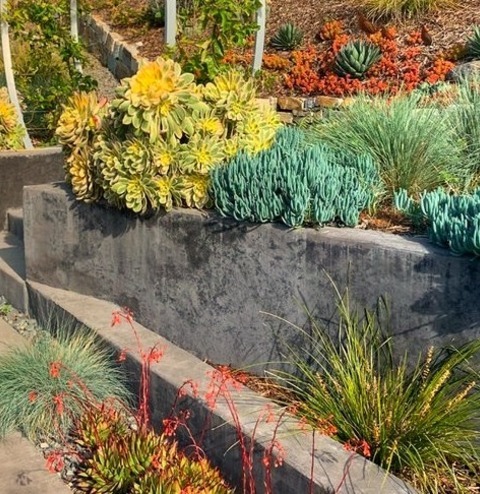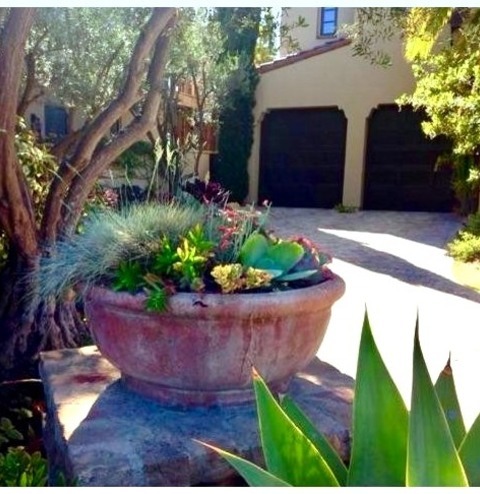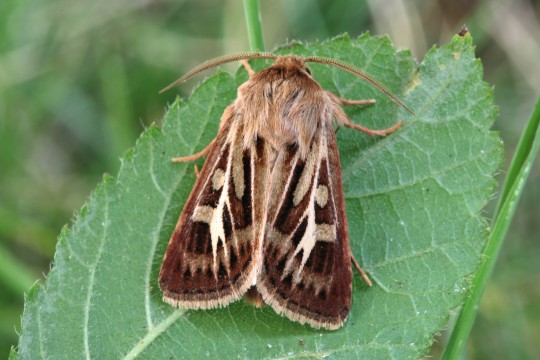#fescue grass
Text
Gravel Front Yard

Ideas for a sizable, drought-resistant, full-sun, gravel garden path in a mid-century modern front yard in the spring.
0 notes
Photo

Landscape
Here is an illustration of a sizable, full-sun, backyard concrete paver garden path in the spring.
#fescue grass#echeveria lipstick#senecio#landscape#lomandra breeze#concrete retaining walls#aeonium sunburst
0 notes
Photo

Pathway - Landscape
#Here is an illustration of a sizable#full-sun#backyard concrete paver garden path in the spring. landscape#fescue grass#circular arbor#lomandra breeze#blue chalk sticks#low water plants#echeveria lipstick
0 notes
Video
n248_w1150 by Biodiversity Heritage Library
Via Flickr:
A new British flora;. London,Gresham Pub. Co.,1919.. biodiversitylibrary.org/page/11332153
#Floras#Great Britain#Plants#Wild flowers#New York Botanical Garden#LuEsther T. Mertz Library#bhl:page=11332153#dc:identifier=https://biodiversitylibrary.org/page/11332153#botanical illustration#scientific illustration#Pellitory-of-the-Wall#Parietaria ramiflora#Silky Wind Grass#Apera Spica-venti#Silvery Hair Grass#Aira caryophyllea#Flat-stalked Poa#Poa compressa#Sand Fescue#Festuca Myuros#Vulpia myuros#annual fescue#rat's-tail fescue#Parietaria judaica#Pellitory of the wall#spreading pellitory#loose silky-bent#common windgrass#silver hairgrass#Canada bluegrass
3 notes
·
View notes
Text
turf grass my enemy

native grass my beloved

#switch grass u-u little and big blue stem u-u river oats u-u omg do i love river oats so much. so cute. path rush. blue joint grass#and yes i love blue joint grass bc it reminds me of weed. of course. indian grass. june grass. side oats grama. upland wild timothy#fox sedge. nodding fescue. canada wild rye. common hops sedge. and dont get me started on the oval sedges u-u#theres so many cool grasses. trust me. im a grass boy. but im more of a... plant the (native) grass and leave it alone type a guy.#WHATS THE POINT OF PLANTING GRASS IF YOU WONT EVEN LET IT MATURE ENOUGH TO SEE THE LITTLE BIRDS EAT THE SEEDS#HUH????????? WHATS EVEN --THE POINT-- THEN?????????????#whats the point *begging and pleading* of planting grass.... *on the floor. on my knees. crying.* if you wont even let it grow big enough#to build microbiomes as homes for small creatures like snakes and lizards and rodents and bugs and such ;-;#WHATS EVEN THE POINT THENNNNNNNNNNNNNNNNNNNNNNNNNNNNNN#grass my beloved ~AS IT IS~ and where it should be *clenches fist and a tear trickles down my cheek*
0 notes
Photo

Transitional Landscape - Fire Pit
Summertime image of a medium-sized, transitional backyard with a fire pit and decking.
0 notes
Photo

San Francisco Landscape Pathway
Here is an illustration of a sizable, full-sun, Mediterranean-style mulch garden path in the summer.
#boulders and plants#festuca siskiyou blue#plants for low water gardens#blue fescue grass#drought tolerant plants#water-wise plants
0 notes
Photo

Fire Pit - Landscape
Summertime image of a medium-sized, transitional backyard with a fire pit and decking.
0 notes
Photo

Contemporary Landscape Providence
An example of a mid-sized contemporary partial sun front yard concrete paver garden path in winter.
0 notes
Photo

Front Yard - Natural Stone Pavers
This is an illustration of a sizable traditional front yard stone landscaping in the summer that can withstand drought and some sunlight.
#purple fountain grass#container gardens#mediterranean-style design#blue fescue#front yard#succulents
0 notes
Photo

Front Yard Natural Stone Pavers San Francisco
Design concepts for a modest front yard stone garden path that can withstand dryness and receives some sunlight in the fall.
#pavers and pebbles#clumping bamboo#clean landscape design#trailing plants#fescue grasses#updated pathway#dramatic plants
0 notes
Text
Chemically sterilized...or mechanically sterilized?
It is clear that applying chemicals to your yard and landscape, be it fertilizers, weed killers, or pesticides, has devastating effects to the community of life that is present in every place.
But is the terrifying decline in insects explainable by chemicals alone?
When i am in mowed environments, even those that I know have no lawn chemicals, they are almost entirely empty of life. There are a few bees and other insects on the dandelions, but not many, and the only birds I see are American robins, Grackles, and European starlings.
Even without any weed killers at all, regular mowing of a lawn type area eliminates all but a few specially adapted weeds.
The plants of a lawn where I live include: Mouse ear chickweed, Birds-eye Speedwell, Common blue violet, Dandelion, Wild Garlic, Creeping charlie, White Clover, Black Medick, Broad-leaved plantain, Mock Strawberry, Crabgrass, Small-flowered Buttercup, Ribwort Plantain, Daisy Fleabane, a few common sedges, Red Deadnettle...That sounds like a lot of plants, but the problem is, almost all of them are non-native species (Only Violets, Daisy Fleabane, and the sedges are native!) and it's. The Same. Species. Everywhere. In. Every. Place.
How come...? Because mowed turf is a really specific environment that is really specifically beneficial to a number of almost entirely European plants, and presents stressors that most plants (including almost all native north american plants) simply can't cope with.
The plants mentioned above are just the flowering weeds. The grasses themselves, the dominant component of the lawn, are essentially 100% invasive in North America, many of them virulently and destructively invasive.
Can you believe that Kentucky bluegrass isn't even native to Kentucky? Nope, it's European! The rich pasture of the Bluegrass region of Kentucky was predominantly a mix of clover, other legumes, and bamboo. The clovers—Kentucky clover, Running buffalo clover, and buffalo clover—are highly endangered now (hell, kentucky clover wasn't even DISCOVERED until 2013) and the bamboo—Giant rivercane, Arundinaria gigantea—has declined in its extent by 98%. Do European white and red clovers fulfill the niches that native clovers once did? Dunno, probably not entirely.
One of the biggest troubles with "going native" is that North America legitimately does not have native grass species that really fill the niche of lawn. Most small, underfoot grassy plants are sedges and they are made for shady environments, and they form tufts and fancy sprays, not creeping turf. Then there's prairie grasses which are 10 feet tall.
What this means, though, is that lawns don't even remotely resemble environments that our insects and birds evolved for. Forget invasive species, lawns are an invasive BIOME.
It's a terrible thing, then, that this is just what we do to whatever random land we don't cover in concrete: back yards, road margins, land outside of churches and businesses, spaces at the edges of fields, verges at bypasses and gas stations...
Mowing, in the north american biomes, selects for invasive species and promotes them while eliminating native species. There's no nice way to put it. The species that thrive under this treatment are invasive.
And unfortunately mowing is basically the only well-known and popular tool even for managing meadow and prairie type "natural" environments. If you want to prevent it from succeeding to forest, just mow it every couple of years.
This has awful results, because invasive species like Festuca arundinacea (a plant invented by actual Satan) love it and are promoted, and the native species are harmed.
Festuca arundinacea, aka Tall Fescue, btw is the main grass that you'll find in cheap seed mixes in Kentucky, but it's a horrific invasive species that chokes everything and keeps killing my native meadow plants. It has leaves like razor blades (it's cut me so deeply that it scarred) and has an endosymbiont in it that makes horses that eat it miscarry their foals.
And this stuff is ALL OVER the "prairie" areas where I work, like it's the most dominant plant by far, because it thrives on being mowed while the poor milkweeds, Rattlesnake Master and big bluestems slowly decline and suffer.
It's wild how hard it is to explain that mowing is a very specific type of stressor that many plants will respond very very negatively to. North American plants did not evolve under pressures that involved being squished, crushed, snipped to 8 inches tall uniformly and covered in a suffocating blanket of shredded plant matter. That is actually extremely bad for many of the prairie plants that are vital keystone species. Furthermore it does not control invasive species but rather promotes them.
Native insects need native plant cover. Many of them co-evolved intimately with particular host plants. Many others evolved to eat those guys. And Lord don't get me started on leaf removal, AKA the greatest folly of all humankind.
So wherever there is a mowed environment, regardless of the use of chemicals or not, the bugs don't have the structural or physical habitat characteristics they evolved for and they don't have the plant species they evolved to be dependent on.
Now let's think about three-dimensional space.
This post was inspired when I saw several red winged blackbirds in the unmowed part of a field perching on old stems of Ironweed and goldenrod. The red-winged blackbirds congregated in the unmowed part of the field, but the mowed part was empty. The space in a habitat is not just the area of the land viewed from above as though on a map. Imagine a forest, think of all the squirrels and birds nesting and sitting on branches and mosses and lichens covering the trunks and logs. The trees extend the habitat space into 3 dimensions.
Any type of plant cover is the same. A meadow where the plants grow to 3 feet tall, compared with a lawn of 6 inches tall, not only increases the quality of the habitat, it really multiplies the total available space in the habitat, because there is such a great area of stems and leaves for bugs and birds to be on. A little dandelion might form a cute little corner store for bugs, A six foot tall goldenrod? That's a bug skyscraper! It fits way more bugs.
It's not just the plants themselves, it's the fallen leaves that get trapped underneath them—tall meadow plants seem to gather and hoard fallen leaves underneath. More tall plants is also more total biomass, which is the foundation of the whole food chain!
Now consider light and shade. Even a meadow of 3ft tall plants actually shades the ground. Mosses grow enthusiastically even forming thick mats where none at all could grow in the mowed portions. And consider also amphibians. They are very sensitive to UV light, so even a frog that lives in what you see as a more "open" environment, can be protected by some tall flowers and rushes but unable to survive in mowed back yard
#anti lawn#kill your lawn#native plants#the ways of the plants#native plant gardening#plants#random#bitching about mowing again
867 notes
·
View notes
Text
Maddie vs. fescue (Maddie, she’s a baddie)
0 notes
Text
Flowering Despite the Heat
Flowering Despite the Heat
This is a hard time for me to be doing any gardening. Although my lawn is a football field blend of grasses with Kentucky bluegrass, tall fescue, and red fescue — a mixture that is supposed to do well in heat and cold, sun and shade — it’s struggling. Even worse, the Bermuda grass that once covered the yard is poking its way through the thick grass and without some sort of intervention, will…

View On WordPress
#daylilies#echinacea#football field mixture of grass#Kentucky bluegrass#pernickety lawn#red fescue#tall fescue
0 notes
Text
Moth of the Week
Antler Moth
Cerapteryx graminis

The antler moth is a part of the family Noctuidae. It was first described in 1758 by Carl Linnaeus. This moth gets its name from the antler shaped mark in its forewings.
Description This moth species has brown forewings, with a “basal streak” of white that branches out. This mark may vary in size per moth. The forewings show a mirrored pattern of the base brown broken up by the branches and a few spots and lines of lighter brown. The forewing also may or may not have black streaks. The hindwing is dark brown with a white fringe.
Males are smaller than females with fluffier antennae.
Male Wingspan: 27 - 32mm (≈1.06 - 1.26in)
Female Wingspan: 35 - 39mm (≈1.38 - 1.53in)
Diet and Habitat The larva of this species feeds on grasses such as Deschampsia, Sheep’s-fescue (Festuca ovina), Mat-grass (Nardus stricta) and Purple Moor-grass (Molinia caerulea). It has also been found on sedges and rushes. When the larva population is concentrated enough, they can damage pastures. Adults feed on flowers such as thistles and ragworts.
This species is common through most of Europe. It’s northernmost reach is Iceland and above the Arctic Circle. It’s easternmost reach is Siberia and North Mongolia. This moth does not occur in the dry southern regions of Europe. It has been introduced to North America. Additionally, this species inhabits the Alps. They prefer habitats of grassland, favouring acid upland pasture, moorland and downland.
Mating Adult moths are seen flying from July to September. They presumably mate in this time frame.
Predators This moth flies during the day, especially in the north, warm weather, and early mornings, and at night. They are presumably preyed on by both daytime and night time predators like birds and bats. They are attracted to light. To protect themselves during the day, this moth hides in the grass.
Fun Fact The antler moth rises to an altitude of 2100 meters in the Alps.
(Source: Wikipedia, Butterfly Conservation)
#libraryofmoths#animals#bugs#facts#insects#moth#lepidoptera#mothoftheweek#antler moth#Noctuidae#Cerapteryx graminis
197 notes
·
View notes
Note
I know that it’s limited what you can tell us at this point. Can you please give us some tidbit about Percy? I just really like him so much!
percy hates lawns. just hates them so much. he regularly stares at the lawns on campus with contempt. he's a natural grasses and plants guy only. if he had to pick, his favorite type of grass is fine fescue. i mentioned it before, but his favorite flowers are clovers and not actual flowers. he also likes moss. he thinks star moss is pretentious, which offends elio. he likes shiny seductive moss, water screw moss and ribbed bog mosses to name a few.
39 notes
·
View notes